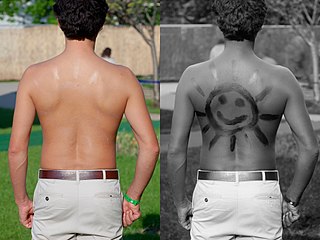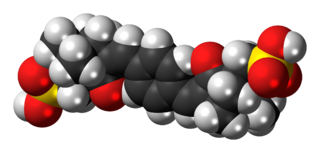
Ultraviolet (UV) is a form of electromagnetic radiation with wavelength shorter than that of visible light, but longer than X-rays. UV radiation is present in sunlight, and constitutes about 10% of the total electromagnetic radiation output from the Sun. It is also produced by electric arcs; Cherenkov radiation; and specialized lights; such as mercury-vapor lamps, tanning lamps, and black lights. Although long-wavelength ultraviolet is not considered an ionizing radiation because its photons lack the energy to ionize atoms, it can cause chemical reactions and causes many substances to glow or fluoresce. Many practical applications, including chemical and biological effects, derive from the way that UV radiation can interact with organic molecules. These interactions can involve absorption or adjusting energy states in molecules, but do not necessarily involve heating.

Oxybenzone or benzophenone-3 or BP-3 is an organic compound belonging to the class of aromatic ketones known as benzophenones. It is a pale-yellow solid that is readily soluble in most organic solvents. It is widely used in sunscreen formulations, plastics, toys, furniture finishes, and other products to limit UV degradation. In nature, oxybenzone can be found in various flowering plants.

Sunscreen, also known as sunblock or sun cream, is a photoprotective topical product for the skin that helps protect against sunburn and most importantly prevent skin cancer. Sunscreens come as lotions, sprays, gels, foams, sticks, powders and other topical products. Sunscreens are common supplements to clothing, particularly sunglasses, sunhats and special sun protective clothing, and other forms of photoprotection.
4-Aminobenzoic acid (also known as para-aminobenzoic acid or PABA because the two functional groups are attached to the benzene ring across from one another in the para position) is an organic compound with the formula H2NC6H4CO2H. PABA is a white solid, although commercial samples can appear gray. It is slightly soluble in water. It consists of a benzene ring substituted with amino and carboxyl groups. The compound occurs extensively in the natural world.

Sun tanning or tanning is the process whereby skin color is darkened or tanned. It is most often a result of exposure to ultraviolet (UV) radiation from sunlight or from artificial sources, such as a tanning lamp found in indoor tanning beds. People who deliberately tan their skin by exposure to the sun engage in a passive recreational activity of sun bathing. Some people use chemical products which can produce a tanning effect without exposure to ultraviolet radiation, known as sunless tanning.

Sunless tanning, also known as UV filled tanning, self tanning, spray tanning, or fake tanning, refers to the effect of a suntan without exposure to the Sun. Sunless tanning involves the use of oral agents (carotenids), or creams, lotions or sprays applied to the skin. Skin-applied products may be skin-reactive agents or temporary bronzers (colorants).

Ecamsule is an organic compound which is added to many sunscreens to filter out UVA rays. It is a benzylidene camphor derivative, many of which are known for their excellent photostability.

Avobenzone is an oil-soluble ingredient used in sunscreen products to absorb the full spectrum of UVA rays.

Octyl methoxycinnamate or ethylhexyl methoxycinnamate (INCI) or octinoxate (USAN), trade names Eusolex 2292 and Uvinul MC80, is an organic compound that is an ingredient in some sunscreens and lip balms. It is an ester formed from methoxycinnamic acid and 2-ethylhexanol. It is a liquid that is insoluble in water.

UV filters are compounds, mixtures, or materials that block or absorb ultraviolet (UV) light. One of the major applications of UV filters is their use as sunscreens to protect skin from sunburn and other sun/UV related damage. After the invention of digital cameras changed the field of photography, UV filters have been used to coat glass discs fitted to camera lenses to protect hardware that is sensitive to UV light.

Octocrylene is an organic compound used as an ingredient in sunscreens and cosmetics. It is an ester formed by the condensation of 2-ethylhexyl cyanoacetate with benzophenone. It is a viscous, oily liquid that is clear and colorless.

2-Ethylhexyl salicylate, or octyl salicylate, is an organic compound used as an ingredient in sunscreens and cosmetics to absorb UVB (ultraviolet) rays from the sun. It is an ester formed by the condensation of salicylic acid with 2-ethylhexanol. It is a colorless oily liquid with a slight floral odor.

Skin care is a range of practices that support skin integrity, enhance its appearance, and relieve skin conditions. They can include nutrition, avoidance of excessive sun exposure, and appropriate use of emollients. Practices that enhance appearance include the use of cosmetics, botulinum, exfoliation, fillers, laser resurfacing, microdermabrasion, peels, retinol therapy, and ultrasonic skin treatment. Skin care is a routine daily procedure in many settings, such as skin that is either too dry or too moist, and prevention of dermatitis and prevention of skin injuries.

Bemotrizinol is an oil-soluble organic compound that is added to sunscreens to absorb UV rays. It is marketed as Parsol Shield, Tinosorb S, and Escalol S.

Bisoctrizole is a phenolic benzotriazole that is added to sunscreens to absorb UV rays. It is a broad-spectrum ultraviolet radiation absorber, absorbing UVB as well as UVA rays. It also reflects and scatters UV.

Drometrizole trisiloxane (INCI) is a lipophilic benzotriazole derivative marketed as Mexoryl XL by L'Oréal and is used in sunscreens to absorb UV radiation. It is a broad-spectrum UV absorber with two absorption peaks, one at 303 nm (UVB) and one at 344 nm (UVA). Just like Mexoryl SX (ecamsule), it is used exclusively in products by L'Oréal owned brands. Drometrizole trisiloxane and ecamsule are often used together, because they show a synergistic effect in protection.

Diethylamino hydroxybenzoyl hexyl benzoate (INCI) is an organic compound used in sunscreens to absorb UVA radiation. It is marketed as Parsol DHHB by DSM and as Uvinul A Plus by BASF. DHHB has an absorption maximum of 354 nm.

Iscotrizinol is an organic compound used in sunscreens to absorb UVB and some UVA radiation with a peak protection at 310 nm. It is one of the most photostable chemical sunscreens known today with 25 hours required to lose 10% of its SPF protection ability. It is marketed as Uvasorb HEB by 3V Sigma.
A Certified Organic Sunscreen, also known as Petrochemical-Free Sunscreen, is a third party certified sunscreen consisting of certified and approved organic ingredients, with typically zinc oxide acting as the photo-protector. An organic sunscreen is verified and approved by a certifier to an international organic standard, such as NSF/ANSI 305, which define production and labelling requirements for personal care products containing organic ingredients. Generally speaking, sunscreen has photo-protective properties that reduce the risk of skin cancer and ageing with relation to the SPF value and proper application.
Z-Cote is a commercial zinc oxide line manufactured and owned by BASF. Due to Z-Cote's photo-protective properties it is commonly used in personal care products and sunscreens. It is available in nano, non-nano, coated and uncoated forms. Z-Cote is a derivative of zinc oxide which is Generally Recognized As Safe and Effective (GRASE) by the FDA as a nutrient, cosmetic colour additive, skin protection active ingredient and other OTC products. Manufactured zinc oxide, such as Z-Cote, is only recognised as GRASE by the FDA when it is compliant with the Good manufacturing practice (GMP) standard. The original Sunsmart Z-Cote patent filed in 1991 for UV skin protection expired in 2015.


















